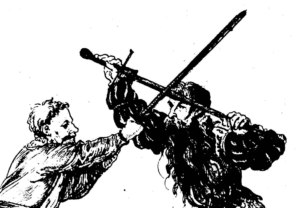We all live in community and the attitude of our fellows impact the depth of our faith as well as how we train in the martial arts. Good intentions are not enough – we must practice what we say we believe.
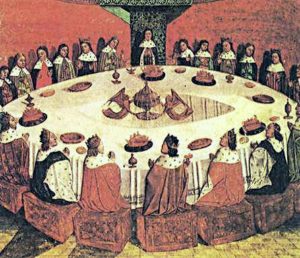
While any collection of people (whether virtual or physical) can be called a community, the strength of the bond between them is the result of the shared interest and each person’s commitment to it. Is it only martial arts and historic studies, or does it include the depth and breadth of the Catholic faith? It is the bonds of faith which are the most lasting, because they anchor our community in a transcendent truth as taught by Jesus and passed on by the Catholic Church throughout the last 2,000 years.
What brings a student of historical fighting arts together with others? If you were to travel back in time, you would see that this craft, sometime called a noble science, was never practiced as a simple leisure activity nor solely for the glory of the person. But rather, with a recognition that as a warrior the fighting man was part of a brotherhood of arms. Whether as some order of Catholic or feudal knight, or gentleman courtier, as scholar in a school of defense or fellow in a fighting guild, learning and practicing the art of arms demanded solidarity among practitioners. Beyond this mere brotherhood of arms, there was also the brotherhood of faith. Belonging to the same faith allowed the men of Catholic knightly orders to share a common point of reference, one that transcended language, kingdom, or even family. The role of faith in the broader context of relationship during this time period is often overlooked by modern practitioners.
One of the offshoots of the concept of the “rugged individual” which is found throughout the culture of the United States, is the idea that we can “go it alone” in everything. Similar to the idea of “me and Jesus”, many modern enthusiasts like to imagine they can train alone in their own “solo art.” It is not true for martial arts practice nor is it true for the faith. We are designed by God to live in commun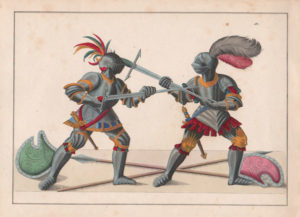 ity – as it says in Proverbs, “iron sharpens iron,” leading to the logical conclusion that you need the iron of others in your life. In the same way, fighting skills are not practiced in a psychological vacuum but with the need for mental and emotional control. A martial discipline cannot be practiced in social isolation, independent from the need to exercise with and against others. Indeed, many religious found the martial arts a help to understanding the greater spiritual combat that we are called to in our Christian life. Outside of faith, even humanist educators of the Renaissance stressed the martial arts as part of their curricula because of its value to help make a better citizen.
ity – as it says in Proverbs, “iron sharpens iron,” leading to the logical conclusion that you need the iron of others in your life. In the same way, fighting skills are not practiced in a psychological vacuum but with the need for mental and emotional control. A martial discipline cannot be practiced in social isolation, independent from the need to exercise with and against others. Indeed, many religious found the martial arts a help to understanding the greater spiritual combat that we are called to in our Christian life. Outside of faith, even humanist educators of the Renaissance stressed the martial arts as part of their curricula because of its value to help make a better citizen.
There is no doubt that, ultimately, self-defense is a highly individual matter that consists largely of self-effort — whether engaged on the battlefield in combat, or in the spiritual temptations we are called to fight. However, the knightly art of arms was never really something to be practiced remotely in seclusion or for some singular occasion, but with one’s fellows—and not just any fellows, but those whose honor was demonstrated and whose respect had been earned. Just as the faith was meant, not to be practiced alone, but with those fellows who were earnestly trying to achieve heaven, and whose council could be trusted in matters of faith. There was no selfish “lone warrior” myth nor much truth to the knight errant, any more than you go to Mass alone to receive the Eucharist. The Art as expressed in the Renaissance source teachings, was taught with the recognition it was intended only for those who were deemed worthy, those trustworthy to receive it. Lest you think faith is much different, Paul writes in 1 Corinthians 3:13, “Every man’s work shall be manifest; for the day of the Lord shall declare it, because it shall be revealed in fire; and the fire shall try every man’s work, of what sort it is.” Our work in pursuit of the faith will be judged and found either worthy or not – we are called to works through our love and faith to prove ourselves just as the Renaissance martial artists judged each other as worthy in a human context. Exactly how much these practices were followed in historical reality, we can never really know. But in striving for best in our faith journey and our martial skills, we teach and demonstrate to others a desire to learn and to strive for mastery of the craft and the faith.
alone to receive the Eucharist. The Art as expressed in the Renaissance source teachings, was taught with the recognition it was intended only for those who were deemed worthy, those trustworthy to receive it. Lest you think faith is much different, Paul writes in 1 Corinthians 3:13, “Every man’s work shall be manifest; for the day of the Lord shall declare it, because it shall be revealed in fire; and the fire shall try every man’s work, of what sort it is.” Our work in pursuit of the faith will be judged and found either worthy or not – we are called to works through our love and faith to prove ourselves just as the Renaissance martial artists judged each other as worthy in a human context. Exactly how much these practices were followed in historical reality, we can never really know. But in striving for best in our faith journey and our martial skills, we teach and demonstrate to others a desire to learn and to strive for mastery of the craft and the faith.
People today often complain about how modern society view the pursuits of life and faith. Modern society tends to over-commercialize many things and trivialize those who seek to live with sincerity, commitment, and deep faith. What drives some to long for the past is seeing how people were able to live an integrated life, where faith and action were equaled teamed to not only teach right and wrong, but created a call to DO right and AVOID wrong. Here we have in this craft a legacy that at once celebrates individual achievement and awards personal effort while it simultaneously acknowledges our shared connection to a Catholic heritage. It has an ability to draw us closer to the men who once defended the faith in a unique way, while also increasing our own understanding of God’s call in our lives. The men in our group strive to live by the traditional dedication to principle and honor.
Although unselfishness is not a feature that immediately springs to mind in regard to either historical research or the practice of a martial discipline, it is a key feature of the Christian life that believers are called to. In pursuit of a restoration of reverence, renewal of a uniquely Catholic sub-culture, and preservation of our heritage the practice of unselfishness is key. So it is worth asking yourself – what is your interest in the martial arts of Renaissance Europe? Are you trying to use them for your own needs? Or do see this as a way to share with others? Or do you see it as even broader – a desire to build the faith, to see more men in relationship with Jesus, to see more people trying to live out His will, and to share your faith and martial skills with others? We work to reconstruct and revive these lost fighting systems, for far more than the history itself. We do it to rebuild and re-energize our Church in a modern age which has thrown off reverence, belief, respect, principle, and honor. Why even seek out others who share our passion if it is not because of something more than just a commonality of collective curiosity? We are much more than a loose affiliation with strangers – we are a community of believers who are committed to a mission.
This craft is about self-improvement and mutual education as a means to rebuild our individual faith as well as he Church as a whole. It is not a group that exists in some virtual social networking media, nor is it defined by shrill online banter, or the pretentious role-play of some imagined nobility, but it is an organized assemblage with real principles and sincere values. As a self-defense art, this discipline can be somewhat centered on the individual, and certainly it is self-preserving and self-realizing. But by pursuing it with the love of neighbor and love of enemy that Jesus called us to, we can engage in our quest in an unselfish manner – neither deceiving nor exploiting one’s fellows. By identifying with the saints and with real historical masters, along with the Church and fighting guilds, we can improve the craft, ourselves, and our larger community. All of this is why petty politicking and commercialism is shunned within our guild.
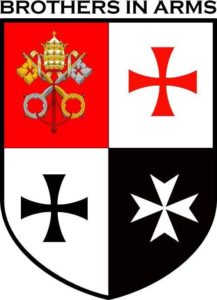
Today, just as in the Renaissance era, those who seek others to train with or a teacher to learn from must do so with a sense of camaraderie, loyalty, morality, and trust. Anything less disrespects our heritage and works against the very ideals the Masters upheld. …Faith, History, Heritage, Self-defense, and Camaraderie. Who could argue with that?
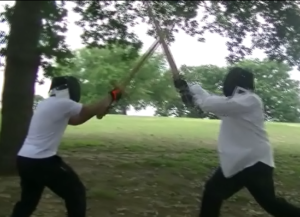 Before we get into how a martial arts practitioner combines faith and love with the art, we should talk a bit about what martial arts really are. First, there is a misconception that true martial arts are Asian; however, the truth is that the term “martial arts” is a European term that refers to the “arts of mars” – the Roman god of war. Therefore any system of self-defense is a “martial art”, including one’s which use modern weapons. The Europeans in the late-Medieval and Renaissance periods created a comprehensive system of self-defense that was documented in books – some of those were written by priests and monks, and many others written lay Catholics. As with any other skill, self-defense systems can be used for good or evil depending on the person.
Before we get into how a martial arts practitioner combines faith and love with the art, we should talk a bit about what martial arts really are. First, there is a misconception that true martial arts are Asian; however, the truth is that the term “martial arts” is a European term that refers to the “arts of mars” – the Roman god of war. Therefore any system of self-defense is a “martial art”, including one’s which use modern weapons. The Europeans in the late-Medieval and Renaissance periods created a comprehensive system of self-defense that was documented in books – some of those were written by priests and monks, and many others written lay Catholics. As with any other skill, self-defense systems can be used for good or evil depending on the person. define love? Since you, the reader, are English-speaking you realize that English uses “love” to describe many different feelings. For instance, “I love pizza” has a totally different meaning than “I love my wife”, which describes a different feeling from “I love my parent/child/sibling.” In other languages that catch-all word of love, gets translated into separate words to more accurately describe the feeling. In Greek (which is what much of the New Testament was written in) we would use Agape, Phileo, Storge, and Eros in place of the English “love.” You can find good explanations at many places on the internet, so I won’t delve into that here (this
define love? Since you, the reader, are English-speaking you realize that English uses “love” to describe many different feelings. For instance, “I love pizza” has a totally different meaning than “I love my wife”, which describes a different feeling from “I love my parent/child/sibling.” In other languages that catch-all word of love, gets translated into separate words to more accurately describe the feeling. In Greek (which is what much of the New Testament was written in) we would use Agape, Phileo, Storge, and Eros in place of the English “love.” You can find good explanations at many places on the internet, so I won’t delve into that here (this 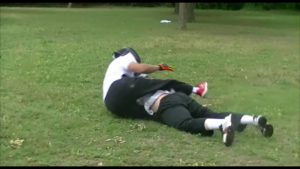 covered to our initial question – “How does a Catholic martial artist love his enemies?” The answer seems to be clear – although we do not show eros, phileo, or storge love to our enemies, we can show agape love. The essence of agape love is an exercise of the will, causing an action where we choose to do something that is in the best interest of another. A practitioner of a martial art who steps in to stop an unjust aggressor from harming an innocent person shows that innocent person agape love. The act of protecting another, while subjecting oneself to possible harm clearly meets that agape definition. If our fictitious doer-of-good-deeds only uses the amount of force necessary to stop the attack (even if that might require deadly force), you could make the argument that agape love was shown to the attacker through restraint. However as a further action, our protector in the story could offer forgiveness to the attacker and pray for his or her conversion (once the danger of aggression has been stopped) and show an even greater example of agape love.
covered to our initial question – “How does a Catholic martial artist love his enemies?” The answer seems to be clear – although we do not show eros, phileo, or storge love to our enemies, we can show agape love. The essence of agape love is an exercise of the will, causing an action where we choose to do something that is in the best interest of another. A practitioner of a martial art who steps in to stop an unjust aggressor from harming an innocent person shows that innocent person agape love. The act of protecting another, while subjecting oneself to possible harm clearly meets that agape definition. If our fictitious doer-of-good-deeds only uses the amount of force necessary to stop the attack (even if that might require deadly force), you could make the argument that agape love was shown to the attacker through restraint. However as a further action, our protector in the story could offer forgiveness to the attacker and pray for his or her conversion (once the danger of aggression has been stopped) and show an even greater example of agape love. I was reading an
I was reading an  the faithful to pray the Rosary for intention of victory, the commander of the Catholic forces ordered his men to pray the Rosary on the morning of battle before the fighting began, and finally the men carried their Rosaries into the battle. Indeed, the prayers of the faithful had been heard, but without the “yes” of those men, without their dedication to fighting against evil and for good the prayers could not have been answered. That very Catholic combination of works in faith is what made the victory possible.
the faithful to pray the Rosary for intention of victory, the commander of the Catholic forces ordered his men to pray the Rosary on the morning of battle before the fighting began, and finally the men carried their Rosaries into the battle. Indeed, the prayers of the faithful had been heard, but without the “yes” of those men, without their dedication to fighting against evil and for good the prayers could not have been answered. That very Catholic combination of works in faith is what made the victory possible.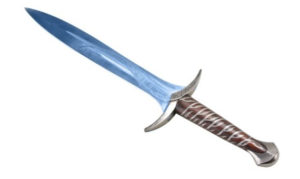 happens next in the story is just as important – once Frodo realized that the immediate danger had passed, he let down his guard. This happens to us too. We turn to God in the dark times, yet as soon as the situation improves we go back to ignoring Him (sometimes not even bothering to say thank you for His help). When we turn from prayer and action too soon, or for too long, the evil that had threatened, returns. In the story Shelob sneaks into a hiding place and sets a trap. Her next attack deprives Frodo of his phial and sword – unable to pray or to defend, he is quickly defeated. How often this occurs to us. We leave our prayer life and our taken by surprise by Satan and sin. Without the protection offered by the spiritual graces, we are quickly subdued and taken. If we are lucky, we have a friend like Samwise Gamgee who will pray for us, defend us, and rescue us when we are in the deepest need.
happens next in the story is just as important – once Frodo realized that the immediate danger had passed, he let down his guard. This happens to us too. We turn to God in the dark times, yet as soon as the situation improves we go back to ignoring Him (sometimes not even bothering to say thank you for His help). When we turn from prayer and action too soon, or for too long, the evil that had threatened, returns. In the story Shelob sneaks into a hiding place and sets a trap. Her next attack deprives Frodo of his phial and sword – unable to pray or to defend, he is quickly defeated. How often this occurs to us. We leave our prayer life and our taken by surprise by Satan and sin. Without the protection offered by the spiritual graces, we are quickly subdued and taken. If we are lucky, we have a friend like Samwise Gamgee who will pray for us, defend us, and rescue us when we are in the deepest need. The mission of Order of Lepanto is to create an active movement of men, who enjoy physical activity and camaraderie in a setting that is faith-building. The decisiveness and audacity required to be a good martial artist is key to getting men prepared to defend their family, the Church, and the society from spiritual threats. When these skills are combined with an active prayer life, men gain the insight and wisdom to lead their families towards God. Our goal is to get men involved and connected with each other and the Church, while building their courage and confidence so as to give glory and honor to God.
The mission of Order of Lepanto is to create an active movement of men, who enjoy physical activity and camaraderie in a setting that is faith-building. The decisiveness and audacity required to be a good martial artist is key to getting men prepared to defend their family, the Church, and the society from spiritual threats. When these skills are combined with an active prayer life, men gain the insight and wisdom to lead their families towards God. Our goal is to get men involved and connected with each other and the Church, while building their courage and confidence so as to give glory and honor to God.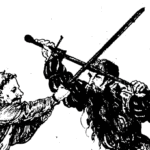 which will keep you burning the calories and losing weight. Additionally, as previously discussed, you will be building muscle mass, which will also help improve your metabolism and allow your body to burn more calories at a rapid pace.
which will keep you burning the calories and losing weight. Additionally, as previously discussed, you will be building muscle mass, which will also help improve your metabolism and allow your body to burn more calories at a rapid pace.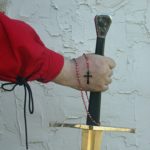 authors and from each in other about spiritual warfare and how to apply the lessons of European martial arts to that spiritual war. We also actively engage in group prayer and stress the importance of personal and family prayer time each day. In combining faith and sparring, we build a bond of brotherhood between the men in our groups. This bond allows us to offer each other fraternal correction and support from a position of trust and respect. We truly help each other to be better men.
authors and from each in other about spiritual warfare and how to apply the lessons of European martial arts to that spiritual war. We also actively engage in group prayer and stress the importance of personal and family prayer time each day. In combining faith and sparring, we build a bond of brotherhood between the men in our groups. This bond allows us to offer each other fraternal correction and support from a position of trust and respect. We truly help each other to be better men.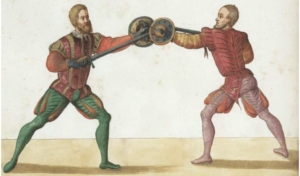 The participation in martial arts, while not for every man, offers great benefits to you in your physical, metal, and spiritual well-being. The Order of Lepanto is on a mission to get men involved and connected with each other and the Church, while building their courage and confidence.
The participation in martial arts, while not for every man, offers great benefits to you in your physical, metal, and spiritual well-being. The Order of Lepanto is on a mission to get men involved and connected with each other and the Church, while building their courage and confidence.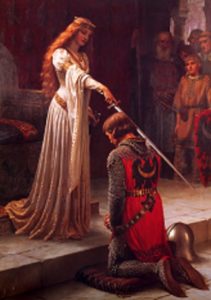 As many of us are painfully aware, there has been a lack of evangelization directed towards men. Men are not hearing what they need from the pulpit and there have been few resources to help in our faith journey. The good news is that this has been changing in recent times, The Order of Lepanto is one of the resources aiding in the shift along with many other fine Catholic men’s blogs. But for many, the call to arms from the hierarchy of the Church was a missing piece of the puzzle.
As many of us are painfully aware, there has been a lack of evangelization directed towards men. Men are not hearing what they need from the pulpit and there have been few resources to help in our faith journey. The good news is that this has been changing in recent times, The Order of Lepanto is one of the resources aiding in the shift along with many other fine Catholic men’s blogs. But for many, the call to arms from the hierarchy of the Church was a missing piece of the puzzle.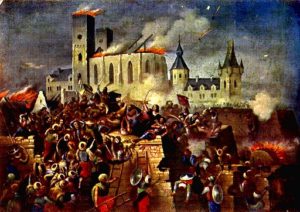
 Much has been written about a lack of men in the faith. The truth is that many men see Catholicism and Christianity as a feminine pursuit, even those who are believers. The truth, however, is strikingly different. God created masculinity just as much as He created femininity, and both must have a place in the Church. The masculine spirit thrives on challenge, adventure, and truth. We want to hear God’s teaching about the right way to do things and be personally challenged to achieve that lofty goal. The true masculinity that God has called us to is not the one where we watch sports all day on Sunday and drink beers with the guys; it is a vibrant and strong relationship where we strive to live God’s calling as spiritual leader and that of beloved son of the Almighty. While there is nothing inherently wrong with those activities, when they are pursued without regard to faith and family our lives become focused on the wrong goal. Too many men are missing from the pews today, and that is just a visible sign of the deeper problem: Too many men are absent from their roles as spiritual leader of their homes. How can we attract men back to the faith? My proposition is that a strong, faith-based martial arts program is one avenue to accomplishing this.
Much has been written about a lack of men in the faith. The truth is that many men see Catholicism and Christianity as a feminine pursuit, even those who are believers. The truth, however, is strikingly different. God created masculinity just as much as He created femininity, and both must have a place in the Church. The masculine spirit thrives on challenge, adventure, and truth. We want to hear God’s teaching about the right way to do things and be personally challenged to achieve that lofty goal. The true masculinity that God has called us to is not the one where we watch sports all day on Sunday and drink beers with the guys; it is a vibrant and strong relationship where we strive to live God’s calling as spiritual leader and that of beloved son of the Almighty. While there is nothing inherently wrong with those activities, when they are pursued without regard to faith and family our lives become focused on the wrong goal. Too many men are missing from the pews today, and that is just a visible sign of the deeper problem: Too many men are absent from their roles as spiritual leader of their homes. How can we attract men back to the faith? My proposition is that a strong, faith-based martial arts program is one avenue to accomplishing this.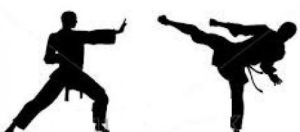 Catholicism. The eastern martial arts (Karate, Tae-kwon do, etc.) are based in eastern mysticism and spirituality which are not entirely compatible with the Christian faith. Many modern people think only of eastern martial arts, but there is a rich history of martial arts in Western Europe, too. The Europeans, with their Catholic faith, created their own martial arts which were (and still are) quite effective. This system covered the use of weapons as well as unarmed confrontations, and many parts were written down so that today, several hundred years later, we can know how many of their techniques worked. Not only are western martial arts effective and compatible with Catholicism, they actually offer the practitioner unique and valuable insights into the spiritual journey and answering the calling of men by God.
Catholicism. The eastern martial arts (Karate, Tae-kwon do, etc.) are based in eastern mysticism and spirituality which are not entirely compatible with the Christian faith. Many modern people think only of eastern martial arts, but there is a rich history of martial arts in Western Europe, too. The Europeans, with their Catholic faith, created their own martial arts which were (and still are) quite effective. This system covered the use of weapons as well as unarmed confrontations, and many parts were written down so that today, several hundred years later, we can know how many of their techniques worked. Not only are western martial arts effective and compatible with Catholicism, they actually offer the practitioner unique and valuable insights into the spiritual journey and answering the calling of men by God.